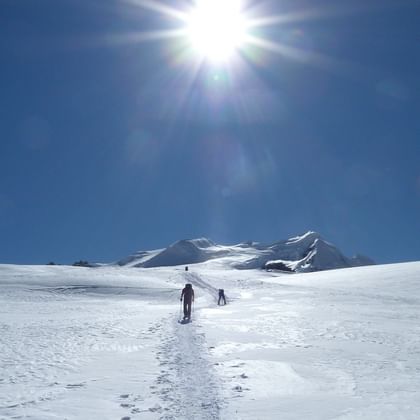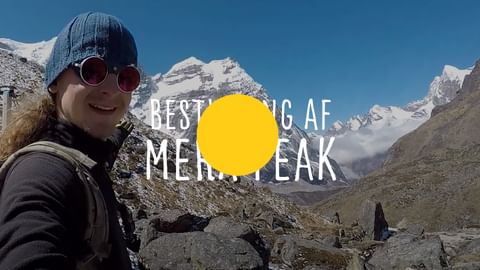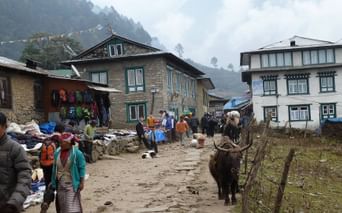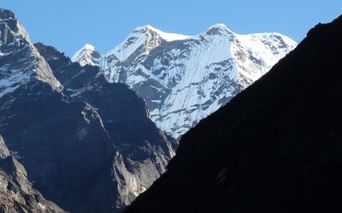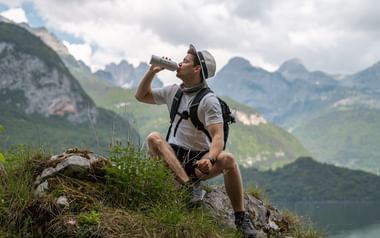Pictures from the trip








Itinerary
Upon arrival in Kathmandu, you will be met at the airport and transported to your hotel. The hotel is located in the area Thamel and after you have rested, you can take a walk around the area. If we have enough time today you will be briefed about the trek and if not it will be done on day two.
Hotel (example): Kathmandu Garden Home
Today, there is a guided tour to two well-known temples. The Hindu temple Pasupatinath and the Buddhist temple Buddhnanath. You will be greeted in the morning by a local guide, and after a delicious breakfast, you will be shown around the city. The Hindu temple Pasupatinath is dedicated to the god Shiva and is located on the banks of the holy Bagmati River. The temple is built in pagoda style with beautifully carved silver doors and is one of the holiest temples in Hindu culture. Pasupatinath Temple is the destination for Hindu pilgrims from around the world during Shivaratri. Only Hindus are allowed to enter the central courtyard of the temple. Tourists must "settle" for viewing the temple from the opposite bank of the Bagmati River.
Next, the journey takes you to the Buddhist temple Bouddhanath, which is the largest stupa (Buddhist mound) in South Asia and the center of Buddhism in Nepal. The ancient and colossal stupa was built in the 600s by King Man Dab of the Lichhabi dynasty. The stupa rests on three large terraces and from above, it takes the form of a lotus flower, which is a highly sacred flower for Buddhists worldwide.
Guided tour: 4-5 hours
Hotel (example): Kathmandu Garden Home
After a delightful breakfast, you will embark on your journey, driving from Kathmandu to Phalpu, enjoying the beautiful views of the green valleys and mountains. After a long drive, you will finally reach Phaplu, a charming village located in the lower Solu Khumbu region. Accommodation in tea houses.
Drive: Approximately 8-9 hours.
Accommodation: Teahouse
The day begins with breakfast and a scenic drive to Khari Khola. Here, the trek commences through the Dudh Koshi Valley, passing traditional farms and charming villages like Panggom, inhabited by Sherpa people engaged in agriculture and trade. Enjoy an overnight stay in the tranquil village of Panggom at a teahouse.
Drive: Approximately 4 hours
Trek: Approximately 3 hours
Accommodation: Teahouse
You begin your trek through a rhododendron and bamboo forest towards Pangkongma La, which stands at an altitude of 3,170 meters. The journey to Pangkongma La follows a gravel trail, offering a spectacular view of Mera Peak. After a well-deserved break at the viewpoint, you start the descent through the pine forest to the Hinku River.
Accommodation: tea house
After having breakfast, you embark on today's adventure. The first part involves a challenging ascent through lush mountain foliage and fields where cows graze. The alpine trek of the day will test your ability to maintain balance as you navigate the sometimes slippery trail. You traverse through grazing fields, mountain vegetation, and a forest of rhododendron and fir before finding a suitable place to spend the night.
Accommodation: Tea house
Today, you head towards Chunbu Kharka, facing about 6 hours of ascent in the high-altitude alpine environment. As you climb towards a mountain pass, you pass through various alpine meadows before reaching Chunbu Kharka.
Accommodation: Teahouse
The majority of the trail to Kothe in the Hinku Valley descends. It's a trek through lush green forest on the steep mountainside. The route is a longer and challenging downward path, requiring extreme caution and adherence to the guide's instructions. In Kothe, you will descend to the riverbank, where you stay overnight.
Accommodation: Teahouse
The hike over the Hinku Khola ridge today leads you to Tagnag. You pass through Gondishung and past the Lungsumgba Monastery, an ancient Buddhist monastery where herders still have the opportunity to participate in temporary summer camps. You continue the trek towards Tagnag, where you stay overnight.
Accomodation: Teahouse
You spend an additional day here to acclimatize to the higher altitude. As part of your acclimatization phase, you go on some hikes and exploration. It will also be possible to review climbing techniques and the use of climbing equipment such as ice axe, crampons, etc.
Accommodation: Teahouse
Today, you trek to Khare via Dig Kharka. You are now at a high altitude, heading towards 4945 meters above sea level. The trek offers spectacular views of snow-covered alpine peaks. You walk steadily towards Dig Kharka and then onwards to Khare. Upon reaching Khare, you are greeted by breathtaking views of Mera Peak.
Accommodation: Teahouse
After breakfast, you head towards Mera Peak Base Camp. The trail is rocky and ascends steeply. After lunch, you can rest or take a stroll in the area to acclimate to the thin air. Back at the base camp, there will be a group briefing on the climbing process and the upcoming ascent route.
Overnight stay in tents.
Accomodation: Tent
After breakfast, you head towards High Camp. Your day becomes a bit more challenging due to a demanding climbing stretch. However, you take it easy, acclimatizing to the atmosphere and surroundings as you ascend towards High Camp. Upon reaching High Camp, your guide will conduct a training session on the ascent to the summit of Mera Peak.
At High Camp, you can enjoy a fantastic view of Mt. Everest, Cho-Oyu, Makalu, Lhotse's south face, Nuptse, Chamlang, and Baruntse.
Accomodation: Tent
Today will be the grand day as we will be going to the summit Mera Peak. Around 2am in the morning we need to get up for breakfast and it's going to be quite cold in beginning but soon we will warm up as we continue up the glacier. The rays of the sun hit the big peaks in an amazing red glow, as we slowly climb higher into the ever-thinning air. At the foot of the final steep summit cone, we may attach to a fixed rope depending on the conditions. The summit is only a few meters away. From the summit, we take in amazing views of the mighty Himalayas including Mt. Everest (8848m), Cho-Oyu (8210m), Lhotse (8516m), Makalu (8463m), Kangchenjunga (8586m), Nuptse (7855m), Chamlang (7319m), Baruntse (7129m) and others. Later, we retrace our steps back to the high camp where we rest for a while before descending to Khare for the overnight stay.
Accomodation: Tea house
We may have reached the Mera Peak summit yesterday and in that case we will spend this day resting upon the great achievement. If for some reason (weather or other unforeseen things) we did not summit yesterday, then this will be our summit day.
Accomodation: Tea house or tent
We treck back from Khare to Kothe using the same trail as before. After reaching Kothe we celebrate our success.
Accomodation: Tent camp at Island Peak Basecamp
Through rhododendron forests on the west side of the Hinku Valley we walk up to Thuli Kharka. After reaching Thuli Kharka, we enjoy the remarkable views of Mera North, Mera Central and South face.
Accomodation: Tea house /tent camp
By ascending to Zatrwa La Pass we begin our trek today and as we cross the pass we are welcomed by the beautiful Lukla Valley. The valley which is surrounded by Cho Oyu, Kongde Peak, Numbur Himal, Kusum Khangru and other Himalayan peaks. Walking down then straining forward we reach the village of Lukla, where we spend the night.
Accomodation: Tea house
While aboard the thirty-minute flight back to Kathmandu, you enjoy your last look glimpse of the mountains you have recently visited. Upon arriving in Kathmandu, we are met and transported to the hotel in Thamel. You have the rest of your day to yourself.
Flight time: approximately 20-30 minutes
Drive time: approximately 4 hours
Hotel (example): Kathmandu Garden Home
(This is a backup day for unforeseen weather issues/cancellations with flights from Lukla.)
Assuming the trip has followed the plan, this day will be used for a guided tour of Kathmandu.
During this walk, you will explore local markets like Ason, the bead market of Indrachowk, the oldest supermarket - New Road, and the hidden Stupa. After discovering these little gems in Kathmandu, you will head to Kathmandu Durbar Square, known for its unique historical, cultural, and religious traditions. A special experience awaits with a visit to the temple of the living goddess "Kumari."
The Durbar Square walk will be a perfect blend of culture, history, art, architecture, and traditional values widespread in the Kathmandu Valley. After the tour, you'll have free time to purchase the last souvenirs or simply enjoy the city's atmosphere. Overnight at a hotel in Kathmandu.
Duration of guided tour: 4-5 hours
Hotel (example): Kathmandu Garden Home
Today is the last day in Nepal. You are transferred to the airport in time to catch your flight home.
Prices and dates
The price includes
- A highly experienced local alpine mountain guide and porters to transport your luggage on the trek
- All accommodation during the trek (cabins, guesthouses and tents)
- 3-star hotels in Kathmandu incl. breakfast
- All meals during the trek
- Transportation to/from the airport
- Land transportation
- Local airfare (Lukla - Ramechhap) + transfer to Kathmandu
- All shared climbing and camping equipment
- Possible rental of missing personal climbing equipment
- Free loan of sleeping bag, down jacket and duffel bags
- TIMS (Trekkers Information Management System)
- Access to national parks, trekking permits, climbing permits
- All temple tickets in Kathmandu
- Food and drinks, lodges, salary, insurance, medical equipment, airfare, ground transportation for trekking staff
- All taxes and fees
- 24-hour local and international service hotline for the duration of the tour
- This is a packaged holiday and is therefore covered by The Travel Guarantee Fund - See which benefits this means for you - click here
- Flight to and from Nepal
- Lunch and evening meals in Kathmandu
- Visa (remember to bring cash and two passport photos)
- Tips see practical information
- Travel insurance and cancellation insurance
- Handling fee € 20
Practical information
This is an international group tour with a local team of guides, porters, and drivers. The price is based on a group of a minimum of 2 persons and a maximum of 10 persons. You will share a double room with another participant on the tour. The tour does not include the flight, which can and should only be purchased once you have secured a spot on the tour.
PLEASE NOTE that day 1 in the program is the day you are supposed to arrive in Kathmandu, which typically means the flight departs from Denmark one day earlier.
Dates: This tour is scheduled as an international group tour, with English as the common language, in 2024 with two possible start dates:
- A spring ascent starting on March 23.
- An autumn ascent starting on October 5.
Check the price quickly
You can quickly check the price of your desired trip without having to fill in anything. Here's how:
- Choose your desired start date
- Click on the green button "See price and reserve your holiday" and go to the booking form
- Select number of people, add any optional extras and see the price at the bottom of the page (you don't have to fill in anything on the form).
Get a quote
For example, if you want a flight included or changes to the trip, you can order a quote for this using the "Get a quote" button. Remember to describe in detail what, if anything, you want changed.
The flights to/from Kathmandu are not included in the price. You can easily find a suitable flight via a flight booking engine such as Momondo or Skyscanner.
Notice: we recommend that you book with us and wait for the confirmation before you book your flights.
Airport transfers
When you arrive at the airport in Kathmandu, you will be picked up and brought to the first hotel. It does not matter what time of day you arrive.
It works like this:
- You book your chosen holiday with us
- We confirm your holiday (usually within 2-3 business days)
- You arrange your transportation
Get a quote
If you prefer that we handle your flight, then we would be happy to arrange this for you. You simply book a quote below the map on this page and we will return with a quote as soon as possible (usually within 48 working hours). Please note that we add a handling fee of 45 euro to each flight and this means that the flight will be cheaper if you book it yourself.
Notice: This is a group tour which requires a minimum number of participants. We urge you to wait with booking your flight until you have recieved the final confirmation from us. We will confirm two months before depature at the latest.
Airport Transfer
Transfer to/from the airport in Kathmandu is included in the price, and you will be picked up regardless of the time of day you arrive.
In Kathmandu you will stay in a tourist class hotel in Thamel. On the trek you stay in teahouses which are guesthouses operated and owned by local families. The quality of the teahouses vary, and we try to book the best possible, but be prepared for primitive conditions. The teahouses often have a common room, which is heated with a stove. You will mostly stay in double rooms and occasionally in multiple-bed rooms with 4-6 beds in each room. The rooms are not heated. You will need a good sleeping bag with a comfort temperature down to -20 degrees Celcius.
At some teahouses it is possible to buy a bath, but be sure to ask whether the water is heated by solar energy, so that we can help to protect the vulnerable forest growth.
Above Base Camp you will stay in tents of normally 2 persons pr. tent.
In Kathmandu breakfast is included, but you need to buy all other meals. Expect about 5-7 euros for a meal.
During the trek, breakfast, lunch and dinner is included in the price. Besides the meals you will get warm drinks (tea, coffee or cocoa) three times pr. day - usually in connection with the meals. Lunch is eaten on the trail. The food selection in the tea houses is very good the menus are virtually the same everywhere. Water for the trek is not included. You can buy bottled water at all teahouses, as well as tea, coffee, cocoa, beer and soft drinks.
During the final climb breakfast, lunch and dinner are included and prepared under primitive conditions in camp.
A typical trekking day begins with a wake-up call between 6:00 - 6:30 am. After getting dressed and having breakfast, you pack your bags in the equipment bags and start walking around 8:00 am. It's important to go at your own pace and take the breaks you need. In the middle of the day, you take a good, long lunch break before continuing the afternoon trek. You arrive at the accommodation in the late afternoon, and after being assigned your rooms, there is plenty of time to relax, explore the village, talk to the locals or your fellow travelers, or read a good book. Dinner is served between 6:00 - 7:00 pm. Most people choose to go to bed early.
On summit days, you start exceptionally early (around 1-2 am) and have a long day of trekking ahead of you.
This trip is graded 5 and 6.
Grade 5
Longer treks of several weeks, involving sleeping in tents and with daily walks of 6-8 hour in demanding terrain. There can be longer climbs over high passes in altitude around 5.000 meter/17.000 feet. Requires good fitness and endurance ability. Previous trekking experience is recommendable. Requires good hiking boots and regular "outdoor" clothing. There will be major fluctuations in temperatures.
Grade 6
Demanding trekking in difficult terrain. These treks or expeditions often involves crossing glaciers or climbing a peak. You have to be in great shape, and previous experience in demanding mountain terrain is recommendable. These expeditions will take you to high altitude and there can be passages that require the use of ropes and crampons. These treks and climbs challenge your physical limits and the experience of the expeditions can be depending on weather. These demanding treks or expeditions often require equipment like harness, climbing boots and crampons.
Read more about our Grading System
Area: 147,181 km²
Population: Approximately 26 million
Religious Holidays/Festivals
Nepal is primarily a Hindu country, heavily influenced by Buddhism. Therefore, there are many religious holidays. Several of the major holidays fall during trekking seasons and can affect activity levels. Take it easy if things don't go according to plan; everything always works out. Diwali is a major Hindu festival of lights also celebrated by Buddhists, among others. The celebration symbolizes the victory over evil. Diwali also honors the Hindu goddess Lakshmi, who represents prosperity, wealth, and beauty. The festival days vary with the lunar calendar each year. In 2016, Diwali is celebrated in the last week of October.
Electricity
You can charge batteries at lodges and hotels. The power voltage is 240 volts, but it can vary greatly in the mountain areas. It is recommended to bring a multi-plug adapter with several options.
Phone and Internet
Country code: +977
Remember to disable automatic updates, data roaming, etc., on your phone/tablet to avoid a surprisingly large bill when you return home. There is increasingly Wi-Fi in many teahouses in the Annapurna area. There is network coverage in many places during the trekking tour, but it is expensive to call home, so many choose to stay in touch with family via SMS. However, there will be areas where it is not possible to get a connection.
Language
Nepal's official language is Nepali, but many dialects are also spoken. Our local guides speak English well, though usually with an accent. In hotels, teahouses, and shops, English is also spoken well. The porters on the trekking tour do not always speak English very well (and yaks not at all!).
Dress Code
In general, the dress code in Nepal is very relaxed, even at the better hotels. It is important to dress with respect for religion and local customs. Therefore, dress modestly and consider when it is appropriate to wear shorts, especially if you are visiting temples and monasteries. It is good etiquette to have your shoulders and knees covered.
Time Difference
Nepal is 4 hours and 45 minutes ahead of Denmark and 3 hours and 45 minutes ahead of Denmark when we have daylight saving time.
Photography
There are countless photo opportunities in Nepal, so make sure you have enough space on your memory card. Show respect for people and ask for permission before taking pictures of them.
Currency and Price Level
The local currency is the rupee (NPR). In Kathmandu, there are many ATMs where you can withdraw money, as well as exchange offices where you can exchange cash in dollars and euros. We recommend that you withdraw/exchange an appropriate amount for the trekking tour before leaving Kathmandu. Most teahouses only accept rupees as a means of payment. Check www.valutakurser.dk for current exchange rates.
Tips
It is customary to give tips in Nepal. In restaurants, the amount is rounded up to about 10% of the bill. It is also common to tip guides and porters, and you should expect to give approximately 80-120 US dollars in tips per person. A good rule of thumb is that for every 10 USD the guide gets, the porters get 6 USD.
It is the customer’s responsibility to have a valid passport. It is also the customer’s responsibility to seek and obtain any necessary visa for travelling to the booked destination. Your passport must be valid for at least 6 months after the expected return. Note that there may be special visa requirements for different foreign nationalities. Please note that processing time for visas to some countries may be several weeks. Mountain Adventures have no responsibility for any lack of travel documents. Be aware of any transit visa requirements.
We advise you to contact a medical specialist or you personal doctor or a licensed vaccination clinic. Please note that you should bring your vaccination certificate when you travel to Nepal.
We recommend taking out travel insurance that covers at least illness, accident, repatriation, lost holiday, luggage and liability. As a customer, you are responsible for taking out the necessary travel insurance to cover these costs.
Before taking out insurance, you should check whether you are already covered by travel or cancellation insurance through your home insurance company, credit card or similar - please note that there may be differences in insurance coverage.
After booking this trip, you get access to various discount schemes.
The best seasons for trekking in the area are spring and autumn. March, April, May, and October, November are fantastic times for trekking. The weather is usually clear with beautiful sunshine in the morning. In the afternoon, some clouds may form from the evaporation of snow in the mountains, but it often clears up again in the evening. In the mountains, temperatures vary significantly depending on the altitude and the time of day. In the middle of the day, it can be warm even at high altitudes, with temperatures reaching up to 20 degrees Celsius at 4,500-5,000 meters. When the sun sets, temperatures drop drastically, and it can easily reach minus 10°C at night at the same altitude. From 5,000 meters and above, the temperature drops rapidly.
We have listed the personal climbing equipment you will need for the ascent. It is possible to rent all items listed here, and this rental is included in the price of the trip. If you have some of the equipment yourself, please bring it along. It is safe to use your own gear. When borrowing climbing boots/mountaineering boots (plastic), it is important to understand that we cannot guarantee all sizes but will find the best possible boots for you. If there is one thing from the list you want to buy yourself, it should be this. The equipment will be reviewed with the local guide upon arrival in Kathmandu.
- Ice axe
- Crampons
- Climbing boots/Mountaineering boots (plastic)
- Climbing harness
- Brakes (belay device and figure-eight)
- Ascender
- Screw carabiners (4 pcs)
- Climbing slings (2 pcs)
- Climbing helmet (optional but recommended)
Here is no text
Travelling to Nepal is always an adventure and you should be prepared for changes along the way. Bering Travel and our good partners always strive to carry out the trips according to the programme, but there may be local conditions and situations where it may be appropriate to adjust the programme along the way. For example, political or natural conditions may cause the guide to change the programme. It may also be the physical ability of the participants, unsuitable climbing weather or delayed flights that require changes to the programme. An extra day is included for summit attempts to maximise the chances of success. It will always be the main guide's decision whether it is safe to attempt the summit. We and our partners always do our best to execute the promised programme, but we are not master of the weather and wind, so if there are changes along the way, take it as an experience.
